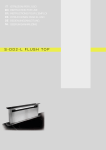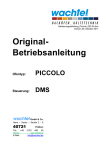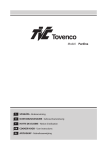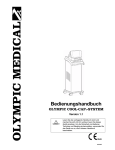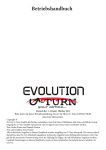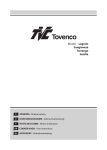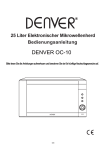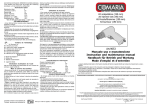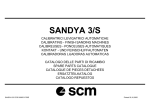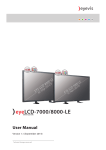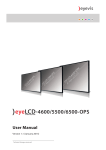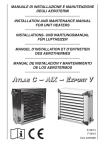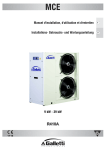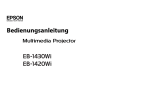Download manuale di istruzioni
Transcript
LIBRETTO ISTRUZIONI INSTRUCTION HANDBOOK · GEBRAUCHSANWEISUNG 2 INFORMAZIONI GENERALI Il presente libretto dovrà essere conservato con cura dall’utente utilizzatore in un luogo protetto e deve essere sempre disponibile per la consultazione, sia da parte dell’operatore che dei tecnici autorizzati. Questo apparecchio deve essere utilizzato solo da adulti fate quindi attenzione che i bambini non si avvicinino con l’intento di giocarvici. Il lavoro di installazione deve essere eseguito, da installatori competenti e qualificati, secondo le norme in vigore. Ogni eventuale modifica che si rendesse necessaria all’impianto elettrico per installare la cappa dovrà essere eseguita solo da persone competenti. L’utilizzo della cappa non può essere diverso da quello di aspiratori di fumi di cottura su cucine domestiche. Qualsiasi utilizzo diverso da questo, solleva il costruttore da qualsiasi responsabilità. Il peso massimo complessivo di eventuali oggetti posizionati o appesi sulla cappa non deve superare i 2 Kg. L’azienda si riserva di apportare ai suoi prodotti, in qualsiasi momento e senza preavviso, eventuali modifiche ritenute opportune per qualsiasi esigenza migliorativa di carattere tecnico commerciale. DIRETTIVE E NORMATIVE DI RIFERIMENTO - - - - Direttiva 2006/95/CE “Bassa tensione” Direttiva 2004/108/CE “Compatibilità elettromagnetica” Norma CEI EN 60335-2-31 + A1 (Sicurezza elettrica) Norme EN 55014-1; EN 61000-3-2; CEI EN 61000-3-3:2009-09 (CEI 210-96); “Compatibilità elettromagnetica” CARATTERISTICHE TECNICHE I dati tecnici della cappa sono contenuti all’interno della stessa togliendo i filtri in metallo. INSTALLAZIONE L’apparecchio deve essere posizionato sopra ed al centro del piano di cottura ad una distanza minima di: - 650 mm nel caso di fornelli elettrici - 750 mm nel caso di fornelli gas o misti. Cappe che montano un motore di portata uguale o superiore agli 800 m3/h devono essere installate con un tubo con diametro minimo di 150 mm dal motore 3 ITALIANO LIBRETTO ISTRUZIONI al camino. Cappe che montano un motore di portata inferiore agli 800 m3/h possono essere installate con un tubo di diametro minimo di 120 mm dal motore al camino. Eventuali modifiche del tubo, brusche riduzioni di diametro, curve possono pregiudicare sostanzialmente un’aspirazione ottimale della cappa ed il funzionamento/durata del motore sollevano il costruttore da qualsiasi responsabilità. Nei tratti orizzontali il tubo deve avere una leggera inclinazione verso l’alto per convogliare agevolmente l’aria all’esterno dell’ambiente. Rispettare tutte le norme relative allo scarico dell’aria. In nessun caso la cappa deve essere collegata a camini di scarico di altri apparecchi (caldaie, scaldabagni, stufe, ecc...). SCHEMA GENERALE DI MONTAGGIO CAPPA ISOLA / PARETE MODELLO ISOLA ( fissaggio a soffitto ) Prima del montaggio verificare che: · Il posizionamento della cappa non vada a coprire prese di corrente, tubature o sia d’intralcio per il funzionamento di altre apparecchiature posizionate nelle vicinanze. · Il soffitto sia in buono stato per garantire l’inserimento e la tenuta dei tasselli di fissaggio. FISSAGGIO Smontare il pannello superiore di fissaggio. Posizionare il pannello sul soffitto al centro di aspirazione considerando anche l’ingombro totale della cappa. Forare in corrispondenza delle feritoie ed inserire i tasselli di fissaggio. Utilizzare tutti i prefori di fissaggio previsti su pannello. Bloccare il pannello al soffitto ed assicurarsi che sia saldamente ancorato. Sollevare la cappa verso il soffitto e riunire il pannello di fissaggio utilizzando tutte le viti previste. Verificare che la cappa sia saldamente fissata al soffitto e non presenti giochi. 4 ITALIANO MODELLO PARETE ( fissaggio a muro ) Prima del montaggio verificare che: · Il posizionamento della cappa non vada a coprire prese di corrente, tubature o sia d’intralcio per il funzionamento di altre apparecchiature posizionate nelle vicinanze. · La parete sia in buono stato per garantire l’inserimento e la tenuta dei tasselli. FISSAGGIO CON ATTACCAGLIE Misurare l’ingombro della cappa e la relativa posizione delle attaccaglie. Riportare sulla parete la posizione delle attaccaglie. Fissare a parete le staffe di supporto. Appendere la cappa sulle staffe di supporto a mezzo delle attacaglie. Togliere i filtri antigrasso e regolare la posizione della cappa a parete agendo sulle viti interne di regolazione delle attaccaglie. Verificare che la cappa sia saldamente fissata a parete e non presenti giochi. FISSAGGIO CON PREFORI EFORI DISTANZA PR ALTEZZA PREFORI Misurare l’ingombro della cappa e la relativa posizione dei prefori. Riportare sulla parete la posizione dei prefori di fissaggio tenendo conto delle distanze d’installazione indicate. Forare la parete ed inserire i tasselli di fissaggio. Togliere i filtri antigrasso, posizionare la cappa a parete ed inserire le viti. Verificare che la cappa sia saldamente fissata a parete e non presenti giochi. INGOMBRO CA PPA 5 IMPIANTO ELETTRICO IMPORTANTE Prima di collegare l’apparecchio alla rete elettrica controllare che: - la tensione d’alimentazione corrisponda a quella indicata dalla targhetta “caratteristiche tecniche”, - la presa di terra sia corretta e funzionante. Prima di effettuare qualsiasi intervento all’interno della cappa scollegare l’apparecchio dalla rete elettrica. Assicurarsi che non vengano scollegati o tagliati fili elettrici all’interno della cappa. Il collegamento deve essere eseguito in conformità con le disposizioni di legge in vigore. Se si collega direttamente la cappa alla rete elettrica, è necessario interporre tra l’apparecchiatura e la rete un interruttore magnetotermico differenziale omnipolare con apertura minima fra i contatti di 3 mm dimensionato al carico e rispondente alle norme in vigore. Il cavo di terra non deve essere interrotto dall’interruttore. Se il cavo di alimentazione è danneggiato, esso deve essere sostituito dal costruttore o dal suo servizio assistenza tecnica o comunque da una persona con qualifica similare, in modo da prevenire ogni rischio. La casa costruttrice declina ogni responsabilità nel caso le norme antinfortunistiche non vengano rispettate. FUNZIONAMENTO COMANDI SLIDER Interruttore luce: •Posizione 0 luce spenta •Posizione 1 luce accesa Interruttore velocità: regola le tre velocità in base alla posizione che si desidera impostare. Gemma spia indica il funzionamento del motore. 6 ITALIANO COMANDI A PULSANTIERA 5 TASTI Pulsante luce: • pigiato luce accesa • non pigiato luce spenta Pulsante 1,2,3, OFF: in base al pulsante pigiato si possono regolare le tre velocità del motore, il tasto OFF spegne il motore. COMANDI A TOUCH CONTROL a seconda della tipologia e al design della cappa possono essere utilizzati due diversi tipi di comandi Pulsante luce: accende e spegne la luce Pulsante “-” “+” e “ventola”: premere il tasto “-” per accendere la ventola; una volta attivata, in base al pulsante pigiato si possono regolare le quattro velocità del motore. Premendo due volte consecutivamente il tasto “ventola” (una volta se già attivo) si spegne la ventola. il tasto TIMER (simbolo orologio) ha la funziona di inserire lo spegnimento automatico. 7 Pulsante luce: accende e spegne la luce. Pulsante “1,2,3” e “ventola”: premere il tasto 1 per accendere la ventola; una volta attivata, in base al pulsante pigiato si possono regolare le quattro velocità del motore. Premendo due volte consecutivamente il tasto “ventola” (una volta se già attivo) si spegne la ventola. il tasto TIMER (simbolo orologio) ha la funziona di inserire lo spegnimento automatico. Funzionamento Timer: Premendo il tasto TIMER durante il normale funzionamento inizierà a lampeggiare il simbolo dell’orologio. Da quando viene inserito il TIMER, la cappa continuerà a funzionare per circa 10 minuti dopo di che si spegnerà automaticamente. In qualsiasi momento della procedura si potrà disinserire il TIMER ripremendone il tasto. In questo modo la cappa continuerà a lavorare come precedentemente impostata. Allarme filtri carbone: Quando la tastiera a motore spento inizierà a lampeggiare significa che i filtri al carbone all’interno della cappa dovranno essere sostituiti per un corretto funzionamento della stessa. Per resettare la tastiera è sufficiente tenere premuto il tasto TIMER fino allo spegnimento dei tasti. 8 ITALIANO COMANDI A TOUCH CONTROL CON TELECOMANDO a seconda della tipologia e al design della cappa possono essere utilizzati due diversi tipi di comandi Attenzione, funzione timer attivabile solo da telecomando! Pulsante luce: accende e spegne la luce Pulsante “-” “+” e “ventola”: premere il tasto “-” per accendere la ventola; una volta attivata, in base al pulsante pigiato si possono regolare le quattro velocità del motore. Premendo due volte consecutivamente il tasto “ventola” (una volta se già attivo) si spegne la ventola. Pulsante luce: accende e spegne la luce Pulsante “1,2,3” e “ventola”: premere il tasto 1 per accendere la ventola; una volta attivata, in base al pulsante pigiato si possono regolare le quattro velocità del motore. Premendo due volte consecutivamente il tasto “ventola” (una volta se già attivo) si spegne la ventola Allarme filtri carbone: Quando la tastiera a motore spento inizierà a lampeggiare significa che i filtri al carbone all’interno della cappa dovranno essere sostituiti per un corretto funzionamento della stessa. Per resettare la tastiera è sufficiente tenere premuto il tasto TIMER fino allo spegnimento dei tasti. 9 TELECOMANDO Per accendere l’aspiratore ed aumentare la velocità della ventola d’aspirazione. Per spegnere l’aspiratore e per diminuire la velocità della ventola d’aspirazione. Ventola per l’attivazione della funzione “TIMER” Per l’accensione e spegnimento delle luci. Il bastoncino a lato, serve per l’apertura del telecomando, nel caso del cambio delle pile. COMANDI A TOUCH SCREEN Pulsante luce: • ON: luce accesa • OFF: luce spenta 10 Premendo il tasto si riduce la velocità del motore. La velocità 1,2,3,4 sono indicate nel display. Premendo il tasto si incrementa la velocità del motore. La velocità 1,2,3,4 sono indicate nel display. La 4° velocità o intensiva è temporizzata e dopo circa 15 minuti il motore passa automaticamente in 3° velocità. 1) Funzione accensione e spegnimento motore cappa. La funzione velocità desiderata permette di avviare il motore con l’ultima velocità selezionata prima del precedente spegnimento. 2) Funzione auto-spegnimento: premendo il tasto modalità per 5 secondi si attiva la funzione timer di auto-spegnimento. Il tempo di auto spegnimento è impostato per default a 15 minuti. Per programmare tale timer premere il tasto e poi agire sui tasti + e – per modificare la durata. L’attivazione di tale funzione è visualizzata dal numero di minuti impostati sul lato destro del display. Timer e saturazione filtri 1) Timer di cortesia: premendo il tasto si attiva la funzione timer con durata impostabile dall’utente e con avvisatore sonoro. Per programmare il timer premere il tasto e poi agire sui tasti + e – per regolare la durata. L’attivazione di tale funzione è visualizzata dal numero di minuti impostati sul display e dal disegno della sveglia sul display. 2) Regolazione orario del display. Per regolare l’orario premere (a cappa spenta) per cinque secondi il tasto: regolare i minuti premendo i tasti + e -, poi premere tasto timer; regolare le ore premendo i tasti + e -, poi premere tasto timer; 3) Saturazione filtri. Dopo circa 30 ore di funzionamento il pulsante propone il lavaggio dei filtri metallici (scritta “wash-filter”). Per disattivare l’allarme premere (a cappa spenta) contemporaneamente i tasti + e – e verificare lo spegnimento della scritta “wash-filter” sul display. Avvertenza: Dopo circa 10 minuti di inattività della cappa, motore o luci spente, si attiva la funzione risparmio energetico con lo spegnimento del backlight del diplay. 11 ITALIANO MANUTENZIONE E PULIZIA NON USARE PRODOTTI ABRASIVI. SCOLLEGARE LA CAPPA DALLA RETE DURANTE LE OPERAZIONI DI PULIZIA. ATTENZIONE: UNA PULIZIA DELL’APPARECCHIO NON ESEGUITA IN CONFORMITÀ ALLE ISTRUZIONI D’USO PUÒ CAUSARE RISCHI DI INCENDIO! MANUTENZIONE ORDINARIA FILTRI ANTIGRASSO METALLICI: Hanno la funzione di trattenere tutte le particelle di grasso in sospensione, pertanto si consiglia di lavarli ogni mese in acqua calda e detersivo o in lavastoviglie, facendo attenzione a non superare i 45°C, a non piegarli; successivamente attendere che siano completamente asciutti prima di posizionarli nel loro alloggio. FILTRI AL CARBONE: Hanno la funzione di trattenere gli odori presenti nel flusso d’aria che li attraversa. I filtri al carbone non possono essere lavati e quindi, devono essere sostituiti mediamente ogni 2 mesi in base all’uso della cappa. PULIZIA DELLA CAPPA La pulizia della cappa esternamente va eseguita usando un panno umido con detersivo del tipo liquido neutro o con alcool, mentre per quella interna è vietato l’utilizzo di liquidi o solventi per le parti elettriche o parti relative al motore. FARETTO ALOGENO: Tutti i faretti alogeni utilizzati sono con innesto rapido a molla/bugna. Non cercare di rimuovere in alcun modo il corpo del faretto dalla sua sede. 12 ITALIANO PER SOSTITUIRE LA LAMPADA ALOGENA SENZA ANELLO (lampada dicroica): - Accertarsi che l’apparecchio sia scollegato dalla rete elettrica. - Togliere, facendo leva con un cacciavite, l’anello di supporto dei vetri. - Togliere il vetro per accedere al vano lampada. - Sostituire la lampada con una analoga (alogena max 20W, 12 Volt attacco G4). - Rimontare il vetro di protezione fissandolo con l’apposito anello. PER SOSTITUIRE LAMPADA FARETTO TONDO CON ANELLO SOSTEGNO VETRO: - Togliete mediante un cacciavite con taglio piatto l’anello di sostegno vetro. Sostituire la lampada con una alogena da 12V attacco G4 con tecnologia bassa pressione autoprotetta. Inserire la nuova lampada senza toccare direttamente con le dita la lampada stessa. - Rimettere il vetrino di protezione e fissarlo riposizionando la ghiera di sostegno vetro come in origine. PER SOSTITUIRE LAMPADA FARETTO ALOGENO QUADRO: - Premere il coperchio del faretto in corrispondenza scritta “push”. In questo modo il coperchio si solleva leggermente. - Tirare con un dito il lembo sollevato del faretto per aprire completamente il coperchio ed accedere alla lampada alogena. - Sostituire la lampada con una analoga (alogena max 20W, 12 Volt attacco G4). - Richiudere il coperchio fino al “CLICK” PUS H ATTENZIONE: PER POTER CHIUDERE NUOVAMENTE IL FARETTO È OBBLIGATORIO, UNA VOLTA PREMUTO IL COPERCHIO IN CORRISPONDENZA DELLA SCRITTA “PUSH”, APRIRE COMPLETAMENTE IL COPERCHIO PER FAR SCATTARE LA MOLLA DI SOSTEGNO NELLA SUA POSIZIONE CORRETTA. 13 PER SOSTITUIRE LAMPADA FARETTO TONDO REGOLABILE: - Togliere la plastica nera. Premere verso l’interno del faretto la plastica nera del punto dove è tagliata in - Togliere il vetrino facendo leva modo da ottenere ciò che si vede nella figura a fianco. con un cacciavite con forza Tirare la molla verso se e toglierla. moderata. - Sostituire la lampadina con un’alogena da 12 V attacco G4 con tecnologia bassa pressione. - Rimettere il vetrino e successivamente la plastica nera. PER SOSTITUIRE IL TUBO FLUORESCENTE (lampada fluorescente): - Scollegare l’apparecchio dalla rete di alimentazione. - Togliere il tubo fluorescente ruotandolo di 90°, e sostituirlo con uno di analoghe caratteristiche (13W-21W-28W a seconda del modello). - Ricollegare l’apparecchio alla rete di alimentazione. MANUTENZIONE STRAORDINARIA LE OPERAZIONI DI MANUTENZIONE STRAORDINARIA (esempio sostituzione motore, condensatore, trasformatore, pulsantiera, morsettiera alimentazione) DEVONO ESSERE ESEGUITE SOLO DA PERSONALE SPECIALIZZATO. AVVERTENZE PER LA SICUREZZA È assolutamente vietato eseguire cotture con sviluppo di fiamma sotto la cappa (es. Flambée). Non utilizzare la cappa in versione aspirante in ambienti dove funzionano in contemporanea altri apparecchi non elettrici (es. stufe a legna, stufe a gas, caldaie a combustibile) con scarico collegato esternamente a meno che non possa essere assicurata una buona areazione dell’ambiente. Se la cappa è utilizzata nella versione aspirante assicurarsi delle buone condizioni della canna fumaria. Non friggere mai lasciando la pentola senza sorveglianza: l’olio contenuto nella pentola può surriscaldarsi ed incendiarsi. Prima di procedere a qualsiasi operazione di pulizia o di manutenzione, disinserire la cappa agendo sull’interruttore generale. Le luci della cappa, dove previste, vanno impiegate solo durante il funzionamento della cappa. Non devono essere utilizzate come fonte luminosa per la stanza... in tal caso la casa costruttrice declina ogni responsabilità. Come anche per eventuali danni che possano, direttamente o indirettamente essere causati a persone, cose ed animali domestici in conseguenza alla mancanza di tutte le prescrizioni indicate nell’apposito libretto istruzioni e concernenti, specialmente, le avvertenze in tema di installazione, uso e manutenzione della cappa. 14 15 16 INSTRUCTION HANDBOOK This booklet must be kept carefully by the user in a safe place and should be always available for consulting, both for the operator and the authorized technicians. This machinery should be only used by adults, therefore be careful that it is kept out of reach of children. The installation should be done by competent and qualified installers, according to the laws and regulations in force. All modifications that may be necessary should be done by qualified people. The hood can’t be used for purposes different from that of exhaust fans for steam on kitchens. The builder declines any responsibility for any different use. The maximum weight of the objects that may be placed or hung on the hood should not exceed 2 kg. Company reserves the right of making changes to its products, at every moment and without previous notice, in order to carry out technical-trade improvement. DIRETTIVE E NORMATIVE DI RIFERIMENTO - - - - Directive 2006/95/EC “Low voltage” Directive 2004/108/EC “Electromagnetic compatibility” Standard EN 60335-2-31 (Electric safety) Standard EN 55014-1; EN 61000-3-2; EN 61000-3-3 “Electromagnetic compatibility” TECHNICAL CHARATERISTICS: The hood technical data are contained inside it. They can be found by removing the metal filters. INSTALLATION The appliance is to be installed centrally over the cooking surface at a minimum distance of: - 650mm from electric hobs - 700mm from gas or mixed hobs This device should be placed above and in the middle of the cooking surface, at a distance of about 650 mm if the cooker has electric rings, otherwise 750 mm if it has gas or mixed fires. Hoods with an engine with a capacity of 800m3/h or more must be to the chimney. Hoods with an engine with a capacity below 800m3/h can be installed with a pipe of at least 120 mm in diameter from the engine to the chimney. 17 ENGLISH GENERAL INFORMATION Possible changes to the pipe, sudden reduction of the diameter, and bends can jeopardize substantially the optimal suction of the hood and the working/ life of the engine and they relieve the manufacturer of any responsibility. In the horizontal parts the tube should be slightly tilted upwards in order to let the air out more easily towards the outside environment. All regulations about the release of gases into the air should be respected. The hood should never be connected to chimneys of other devices (boilers, geysers, stoves etc.). INSTALLATION DIAGRAM HOODS: MODEL ISLAND / MODEL WALL MODEL ISLAND (fastening to the ceiling) Before installation check that. the position of the hood does not block any sockets or piping and does not interfere with any other nearby equipment the ceiling is in good condition so that the anchors can be properly inserted and they can hold. FASTENING Remove the upper fastening panel. Position the panel on the ceiling centering it above the stove taking the hood overall dimensions also into consideration. Drill by the slits and insert the anchors. Use all prebored holes present on the panel. Fasten the panel to the ceiling and make sure it is firmly anchored. Lift the hood towards the ceiling and join the fastening panel using all provided screws. Check that the hood is firmly anchored to the ceiling with no play. 18 MODEL WALL (fastening to the wall) Before installation check that: - the position of the hood does not block any sockets or piping and does not interfere with any other nearby equipment - the wall is in good condition so that the anchors can be properly inserted and they can hold. FASTENING BY MEANS OF WALL HOOKS ENGLISH Measure the hood dimensions and the corresponding position of wall hooks. Mark the position of wall hooks on the wall. Fasten the support brackets to the wall. Hang the hood on the support brackets by means of wall hooks. Remove antifat filters and adjust the hood position on the wall by using internal adjusting screws of wall hooks. Check that the hood is firmly anchored to the wall with no play. FASTENING BY MEANS OF PREBORED HOLES LES DISTANCE PREBORED HO PREBORED HOLES HEIGHT Measure the hood dimensions and the corresponding position of prebored holes. Mark the position of prebored holes on the wall taking shown installation distances into consideration. Drill the wall and insert the anchors. Remove antifat filters, position the hood on the wall and insert the screws. Check that the hood is firmly anchored to the wall with no play. IONS HOOD DIMENS 19 ELECTRIC INSTALLATION IMPORTANT Before connecting the device to the electric system, make sure that: - the input voltage corresponds to the one indicated on the label “technical characteristics” - the ground clamp is adequate and functioning. Before doing anything inside the hood, disconnect it from the electric system. Make sure that wires inside the hood are not cut or disconnected. The connection needs to be done according to the provisions of the law in force. If the hood is connected to the electric system, it is necessary to put an omnipolar differential magnetotermic switch between the device and the net; this switch should have a minimum 3 mm cutoff between the contacts according to the load and should correspond to the laws in force. The ground clamp should not be interrupted by the switch. If the supply cord is damaged, it must be replaced by the manufacturer or its service agent or a similarly qualified person in order to avoid a hazard. The manufacturer declines any responsibility if the safety regulations are not respected. WORKING SLIDER CONTROLS Lighting switch: •Mode 0 light off •Mode 1 light on Speed switch: it regulates the three speeds according to the mode you want to set. The LED indicates the motor operation. 20 Push button: ENGLISH 5 KEYS PUSH-BUTTON PANEL CONTROLS • if pushed light on • if not pushed light off • push button 1,2,3, OFF: according to the pushed button you can set the three motor speeds; OFF push button turns off the motor. TOUCH CONTROLS According to the type and design of the hood two different types of controls can be used. Light switch: switches the light on and off Push buttons “-” “+” and “fan”: press push button “-” to turn the fan on; once activated, according to which push button is pressed, the four motor speeds can be adjusted. By pressing push button “fan” twice consecutively (or once, if the fan is on) the fan switches off. With Push button TIMER (clock symbol) the automatic switch off can be set. 21 Light switch: switches the light on and off Push buttons “1, 2, 3” and “fan”: press push button 1 to turn the fan on; once activated, according to which push button is pressed, the four motor speeds can be adjusted. By pressing push button “fan” twice consecutively (or once, if the fan is on) the fan switches off. With Push button TIMER (clock symbol) the automatic switch off can be set. Timer function: By pressing the TIMER push button while the hood is working, the clock symbol will start flashing. Once the TIMER is set, the hood will continue working for about 10 minutes and then it will automatically switch off. The TIMER can be switched off at any moment by pressing its push button. In this case, the hood will continue working as previously set. Carbon filters alarm: When, being the motor off, the push-button panel starts blinking, it means that the carbon filters inside the hood must be replaced for its correct working. In order to reset the push-button panel it is simply keep push button TIMER pressed until the keys switch off. 22 TOUCH CONTROL SYSTEM WITH REMOTE CONTROL According to the type and design of the hood two different types of controls can be used ENGLISH Warning: the timer function can only be activated with the remote control! Light switch: switches the light on and off Push buttons “-” “+” and “fan”: press push button “-” to turn the fan on; once activated, according to which push button is pressed, the four motor speeds can be adjusted. By pressing push button “fan” twice consecutively (or once, if the fan is on) the fan switches off. Light switch: switches the light on and off Push buttons “1, 2, 3” and “fan”: press push button 1 to turn the fan on; once activated, according to which push button is pressed, the four motor speeds can be adjusted. By pressing push button “fan” twice consecutively (or once, if the fan is on) the fan switches off. Carbon filters alarm: When the engine is off and the keyboard starts flashing, it means that the carbon filters inside the hood must be replaced in order to ensure its correct working. In order to reset the keyboard just keep the TIMER button pressed until the keys switch off. 23 THE REMOTE CONTROL To switch the extractor fan on and to increase the speed of the extractor fan. To switch the extractor fan off and to decrease the speed of the extractor fan. Fan to activate the “TIMER” function To switch the lights on and off. The little stick along the side can be used to open the remote control, when it is necessary to replace the batteries. TOUCH SCREEN CONTROL PANEL Light switch: By pressing the push button, the motor speed decreases. Speed modes 1, 2, 3, 4 are displayed on the panel. 24 • ON: light on • OFF: light off By pressing the push button, the motor speed increases. Speed modes 1, 2, 3, 4 are displayed on the panel. Speed mode 4, or intensive, has a limited time span and after 15 minutes the motor will automatically switch to speed mode 3. 1) Hood motor power ON and power OFF function. The function desired speed mode switches the motor on at the speed mode that was in use when the hood was last switched off. 2) Automatic switch off function: by keeping the push button pressed for 5 seconds the automatic switch off function is activated. The automatic switch off time is set to 15 minutes by default. In order to set the timer press the push button and then use push buttons + and – to set the duration. The activation of the function is displayed by the number of minutes on the right side of the panel. Timer and filter saturation 1) Courtesy timer: he push button activates the user-manageable timer function with warning buzzer. In order to set the timer press the push button and then use push buttons + and – to set the duration. The activation of the function is displayed by the number of minutes set on the panel and by the alarm clock symbol on the panel. 2) Panel display time setting: in order to set the time (the hood must be off) press the push button for 5 seconds: set the minutes by pressing push buttons + and -, then press push button timer; set the hours by pressing push buttons + and -, then press push button timer; 3) Filter saturation. After about 30 operating hours, the push button will suggest metallic filter cleaning (“wash-filter” sign). In order to deactivate the alarm, (the hood must be off) press push buttons + and – simultaneously and check that the “wash-filter” sign on the panel display goes off. Warning: After about 10 minutes of hood inactivity, with motor or lights off, the energy saving function activates and the panel display backlight goes off. 25 ENGLISH MAINTENANCE AND CLEANING DO NOT USE ABRASIVE PRODUCTS DISCONNECT THE HOOD FROM THE ELECTRIC SYSTEM DURING CLEANING. ATTENTION: CLEANING WITHOUT RESPECTING THE INSTRUCTIONS CAN CAUSE RISK OF FIRE. ORDINARY MAINTENANCE METALLIC ANTIGREASE FILTERS: They are designed to hold all suspended fat particles, it is therefore recommended to wash them every month by using hot water and detergents or in the dishwasher. By doing this make sure not to exceed 60°C. Do not to bend them and wait for them to be completely dry before placing them back into position. CARBON FILTERS: their function is trap odours that are in the air that goes through them. These carbon filters cannot be washed, so they need to be replaced every two months roughly, depending on the use. HOOD CLEANING The external cleaning of the hood should be done with a damp cloth and neutral detergent or alcohol. For the internal cleaning, it is forbidden to use liquid or solvents for the electrical parts or the engine. HALOGEN SPOTLIGHT: All the halogen spotlights used have a rapid connection with spring/bump. Do not try to remove the body of the spotlight from its seat. 26 FOR THE REPLACEMENT OF THE BULB(dichroic bulb): - make sure the device is disconnected - pushing with a screw driver, remove the ring that backs up the glass - remove the glass to get to the bulb - replace the bulb with a neon one (neon bulb max 20w, 12 volts connector G4) - put back the protection glass and back it up with the ring. ENGLISH ROUND SPOTLIGHT WITH THE GLASS SUPPORTING RING REPLACEMENT: - Remove the glass supporting ring by using a flat edge screwdriver. Replace the lamp with a self-protected 12V halogen lamp G4 coupling with low pressure technology. Insert the new lamp without touching it directly with your fingers. - Replace the protecting glass and fix it by lodging the glass supporting ring back in place. SQUARE HALOGEN SPOTLIGHT BULB REPLACEMENT: - Press on the “push” sign of the spotlight cover so that the cover lifts lightly. - Pull the lifted cover with a finger to open the cover wide PUS H and reach for the halogen bulb. - Replace the bulb with a similar one (max 20W, G4 base 12V halogen bulb). - Close the cover back till it shuts with a “CLICK” WARNING: IN ORDER TO BE ABLE TO CLOSE THE SPOTLIGHT AGAIN, ONCE THE COVER IS OPENED BY PRESSING ON THE “PUSH” SIGN, IT IS MANDATORY THAT THE COVER BE OPENED WIDE TO TRIGGER THE SPRING SUPPORT AND MAKE IT SETTLE IN ITS CORRECT POSITION. 27 ADJUSTABLE ROUND SPOTLIGHT BULB REPLACEMENT: - Remove the black plastic ring. Push one end of the cut in the black plastic ring towards the centre of the - Remove the glass by gently spotlight as shown in the picture on the right. Pull levering with a screwdriver. the spring towards you and remove it. - Replace the bulb with a low-pressure technology G4 base 12V halogen bulb. - Put the glass back on. - Put the black plastic ring back on. FLOURENSCENT BULB REPLACEMENT: Replacing the fluorescent tube: - disconnect the device - remove the fluorescent tube by turning it by 90 degrees, and replace it with one that has similar characteristics (13w-21w-28 according to the model) - reconnect the device. EXTRAORDINARY MAINTENANCE THE EXTRAORDINARY MAINTENANCE OPERATIONS (ENGINE REPLACEMENT EXAMPLE, CONDENSER, TRANSFORMER, PUSH-BUTTON PANEL, INPUT TERMINAL BOARD) HAVE TO BE DONE BY SPECIALISED PERSONNEL ONLY. SAFETY WARNINGS It is absolutely forbidden to cook with an open fire under the hood (e.g. Flambèe). Do not use the hood in sucking version in environments where other non-electrical devices are being used (for example wood-burning stoves, gas stoves, fuel boilers) with external discharge unless it can be reassured by a good aeration of the environment. If the hood is used in the sucking version, make sure the flue conditions are good. Do not ever fry leaving the pan without being watched: the oil contained in the pan can heat up and catch fire. Before proceeding with any maintenance or cleaning, disconnect the hood using the main switch. The hood lights, when available, must only be used when the hood is functioning. They must never be used to light a room. In such a case, the manufacturer shall not be held responsible for any inconvenience. The manufacturer declines any responsibility for any damage that can, directly or indirectly, be caused to people, things and pets, because of the lack of all prescriptions written in the instruction handbook and concerning the warning about the hood installation, use and maintenance. 28 29 30 GEBRAUCHSANWEISUNG Die hier vorliegende Gebrauchsanweisung muss vom Benützer in einem geschützten Ort aufbewahrt werden und jederzeit sowohl dem Bediener als auch dem berechtigten Techniker zum Durchlesen zur Verfügung stehen. Dieses Gerät darf nur von Erwachsenen benutzt werden, man muss deshalb darauf achten, dass sich dem Gerät keine Kinder sich nähern, um damit zu spielen. Die Installation muss von kompetenten und qualifizierten Installateuren den geltenden Vorschriften gemäß durchgeführt werden. Jegliche zur Installation der Haube eventuell nötige Änderung an die elektrische Anlage darf nur vom kompetenten Personal vorgenommen werden. Die Haube darf nur als Absauganlage vom Kochdampf in Haushaltsküchen benutzt werden. Jedwede andere Verwendung enthebt den Hersteller jeglicher Verantwortung. Das Gesamtgewicht eventueller auf der Haube positionierten oder an der Haube gehängten Gegenständen darf maximal zwei Kilo betragen. Gesellschaftbehält sich das Recht vor, jederzeit und ohne Vorankündigung notwendige Änderungen für jegliche Verbesserung technischer und kaufmännischer Art an seinen Produkten vorzunehmen. HINWEISE AUF RICHTLINIEN UND NORMEN - - - - Richtlinie 2006/95/CE “Niederspannung” Richtlinie 2004/108/CE “elektromagnetische Verträglichkeit” Norm EN 60335-2-31 (Elektrische Sicherheit) Normen EN 55014-1; EN 61000-3-2; EN 61000-3-3 “Elektromagnetische Verträglichkeit” TECHNISCHE DATEN Die technischen Daten des Geräts findet man innerhalb der Haube, indem man die Metallfilter entfernt. INSTALLATION Das Gerät muss zentral über das Kochfeld installiert werden (Gärzeit ab einem Mindestabstand von: - 650mm für elektrische Herden - 750mm für gemischte oder Gasherden). Abzugshauben, die einen Motor mit einer Leistung von oder über 800 m3/h haben, müssen mit einem Rohr vom Motor zum Schornstein installiert werden, das einen Mindestdurchmesser von 150 mm hat. 31 DEUTSCH ALLGEMEINE INFORMATIONEN Abzugshauben, die einen Motor mit einer Leistung unter 800 m3/h haben, können mit einem Rohr vom Motor zum Schornstein installiert werden, das einen Mindestdurchmesser von 120 mm hat. Mögliche Veränderungen des Rohres, beträchtliche Durchmesserverringerungen und Kurven können das ideale Absaugen der Abzugshaube und den Betrieb/die Lebensdauer des Motors beeinträchtigen und sprechen den Hersteller von jeglicher Haftung frei. Die horizontalen Rohrabschnitte müssen leicht aufwärts geneigt sein, um die Luft mühelos aus dem Raum zu entfernen. Alle den Luftabzug betreffenden Normen müssen beachtet werden. Auf keinen Fall muss die Haube mit Abzugsrohren anderer Geräte (Kessel, Boiler, Öfen, usw.) verbunden werden. ALLGEMEINER INSTALLATIONSPLAN HAUBEN: MODELL INSEL / MODELL WAND MODELL INSEL (Deckenbefestigung) Vor der Installation muss Folgendes kontrolliert werden: - Die Positionierung der Haube darf weder Steckdosen noch Rohrleitungen verdecken oder das Funktionieren anderer in der Nähe liegenden Einrichtungen behindern. - Die Zimmerdecke muss in einem guten Zustand sein, damit die Befestigungsdübel richtig befestigt werden und halten können. BEFESTIGUNG Die obere Befestigungsplatte ausbauen. Die Platte an die Decke zentral über die Kochstelle positionieren; dabei muss man auch den Gesamtraumbedarf der Haube berücksichtigen. An den Schlitzen durchbohren und die Befestigungsdübel eindrücken. Alle auf der Platte vorhandenen Vorbohrungen verwenden. Die Platte an der Decke befestigen und sich versichern, dass sie fest verankert ist. Die Haube nach der Decke aufheben und die Befestigungsplatte mit allen vorgesehenen Schrauben wieder zusammensetzen. Kontrollieren, dass die Haube an der Decke fest befestigt ist und kein Spiel hat. 32 MODELL WAND (Wandbefestigung) Vor der Installation muss Folgendes kontrolliert werden: - Die Positionierung der Haube darf weder Steckdosen noch Rohrleitungen verdecken oder das Funktionieren anderer in der Nähe liegenden Einrichtungen behindern. - Die Wand muss in einem guten Zustand sein, damit die Befestigungsdübel richtig befestigt werden und halten können. BEFESTIGUNG MITTELS WANDHAKEN DEUTSCH Die Haubengröße und die entsprechende Position der Wandhaken messen. Die Position der Wandhaken an die Wand markieren. Die Stützbügel an der Wand befestigen. Die Haube mit den Wandhaken an die Stützbügel hängen. Die Antifett-Filter entfernen und die Position der Haube mit den inneren Verstellschrauben der Wandhaken an der Wand einstellen. Kontrollieren, dass die Haube an der Wand fest befestigt ist und kein Spiel hat. BEFESTIGUNG MITTELS VORBOHRUNGEN EN-ABSTAND VORBOHRUNG E HAUBENGRÖß HE VORBOHRUNGEN-HÖ Die Haubengröße und die entsprechende Position der Vorbohrungen messen. Die Position der Vorbohrungen an die Wand markieren; dabei muss man die angegebenen. Installationsabstände berücksichtigen. Die Wand durchbohren und die Befestigungsdübel eindrücken. Die Antifett-Filter entfernen, die Haube an die Wand positionieren und die Schrauben einstecken. Kontrollieren, dass die Haube an der Wand fest befestigt ist und kein Spiel hat. 33 ELEKTRISCHE ANLAGE WICHTIG Bevor das Gerät an das Stromnetz anzuschließen, darauf achten, dass: - Die Versorgungsspannung der auf dem Schildchen “Technische Daten“ verzeichneten Spannung entspricht; - Der Erder korrekt und funktional ist. Das Gerät muss vom Stromnetz getrennt werden, bevor irgendeine Operation innerhalb der Haube vorgenommen wird. Darauf achten, dass keine Kabel innerhalb der Haube abgetrennt oder abgeschnitten werden. Der Anschluss muss den geltenden Vorschriften gemäß erfolgen. Wenn man die Haube direkt an das Stromnetz anschließt, muss ein magnetothermischer omnipolarer nach dem Last bemessene und den geltenden Vorschriften entsprechende Differentialschalter mit einer Minimalöffnung zwischen den Kontakten von 3 mm zwischen dem Gerät und dem Netz gesetzt werden. Das Erdungskabel darf nicht vom Schalter unterbrochen werden. Wenn das Netzkabel beschädigt ist, muss es vom Hersteller oder vom technischen Kundendienst oder von einer Person mit ähnlicher Qualifikation ausgetauscht werden, damit jede Gefahr vermieden werden kann. Die Herstellfirma lehnt jegliche Verantwortung ab, sollten die Unfallverhütungsnormen nicht respektiert werden. ARBEITSWEISE SLIDER KOMMANDOS Lichtschalter: •Position 0 Licht aus •Position 1 Licht ein Geschwindigkeitsschalter: reguliert die drei Geschwindigkeiten je nach der gewünschten Position. Die Kontrolllampe zeigt das Funktionieren des Motors an. 34 KOMMANDOS AUF FÜNFTASTIGER SCHALTTAFEL Licht-Taste: • gedrückt: Licht ein • nicht gedrückt: Licht aus • Druckknöpfe 1, 2, 3, OFF-Taste: je nach gedrücktem Knopf können die drei Geschwindigkeiten des Motors reguliert werden; die OFF-Taste schaltet den Motor aus. DEUTSCH BERÜHRUNGSSTEUERUNG Je nach Art und Design der Saugkappe können 2 unterschiedliche Steuerungen benutzt werden: Licht-Taste: schaltet das Licht ein und aus. Taste “-” “+” und “Luftflügel”: Taste “-” drücken zum Einschalten des Luftflügels; wenn sie dann gedrückt wird, kann man die 4 Geschwindigkeiten steuern. Durch das Doppeldrücken der Taste “Luftflügel” (einmal, wenn sie bereit aktiv ist), schaltet sich der Luftflügel aus. Die Taste “TIMER” (Uhrzeit-Symbol) schaltet das automatische Löschen ein. 35 Licht-Taste: schaltet das Licht ein und aus. Die Taste 1,2,3 und Luftflügel: die Taste 1 drücken zum Einschalten des Luftflügels. Wenn sie aktiviert wird, je nach gedrückter Taste können die 4 Motorengeschwindigkeiten gesteuert werden. Durch das Doppeldrücken der Taste “Luftflügel” (einmal, wenn er bereit aktiv ist), schaltet sich das Luftflügel aus. Die Taste “TIMER” (Urhzeit-Symbol) schaltet das automatische Löschen ein. Timer – Betrieb: Wenn die Taste Timer beim Normalbetrieb gedrückt wird, fängt das Uhr-Symbol zu blonken an. Seitdem das TIMER aktiviert wird, funktioniert die Saugkappe ca. 10 Minuten lang, Danach schaltet sie sich automatisch aus. Jederzeit kann man das TIMER deaktivieren, beim drücken dieser Taste. Auf diese Weise arbeitet die Kappe wie sie vorhin eingestellt war. Kohlefilter Alarm: Beim ausgeschalteten Motor signalisiert das Blinken der Tastatur, dass die Kohlefilter in der Haube ersetzt werden müssen, um das richtige Funktionieren der Haube zu gewährleisten. Um die Tastatur zurück zu stellen reicht es aus, die TIMER-Taste so lange gedrückt zu halten, bis zum Schalten der Taste aus. 36 BERÜHRUNGSSTEUERUNG MIT FERNBEDIENUNG Je nach Art und Design der Saugkappe können 2 unterschiedliche Steuerungen benutzt werden: Achtung: Timerfunktion nur durch Fernbedienung zuschaltbar! Licht-Taste: schaltet das Licht ein und aus. DEUTSCH Taste “-” “+” und “Luftflügel”: Taste “-” drücken zum Einschalten des Luftflügels; wenn sie dann gedrückt wird, kann man die 4 Geschwindigkeiten steuern. Durch das Doppeldrücken der Taste “Luftflügel” (einmal, wenn sie bereit aktiv ist), schaltet sich der Luftflügel aus. Licht-Taste: schaltet das Licht ein und aus. Die Taste 1,2,3 und Luftflügel: die Taste 1 drücken zum Einschalten des Luftflügels. Wenn sie aktiviert wird, je nach gedrückter Taste können die 4 Motorengeschwindigkeiten gesteuert werden. Durch das Doppeldrücken der Taste “Luftflügel“ (einmal, wenn er bereit aktiv ist), schaltet sich das Luftflügel aus. Kohlefilter Alarm: Beim ausgeschalteten Motor signalisiert das Blinken der Tastatur, dass die Kohlefilter in der Haube ersetzt werden müssen, um das richtige Funktionieren der Haube zu gewährleisten. Um die Tastatur zurück zu stellen reicht es aus, die TIMER-Taste so lange gedrückt zu halten, bis zum Schalten der Taste aus. 37 FERNBEDIENUNG Schaltet das Sauggerät ein und erhöht die Geschwindigkeit des Luftansauglüfters Schaltet das Sauggerät aus und sinkt die Geschwindigkeit des Luftansauglüfters. Luftflügel zur Einschaltung der “TIMER” Funktion Schaltet die Lichter ein und aus Das seitliche Stäbchen wird beim Batterieauswechseln benutzt, um die Fernbedienung zu öffnen. TOUCHSCREEN STEUERUNGEN Licht-Taste: - ON: Licht ein - OFF: Licht Aus 38 Wenn diese Taste gedrückt wird, sinkt die Geschwindigkeit des Motors herab. Die Geschwindigkeiten 1,2,3,4 werden auf dem Display angezeigt Wenn diese Taste gedrückt wird, wird die Geschwindigkeit des Motors erhöht. Die Geschwindigkeiten 1,2,3,4 werden auf dem Display angezeigt; die 4.te Geschwindigkeit, oder intensive, ist zeitlich gesteuert und nach 15 Minuten geht der Motor automatisch auf die 3.te Geschwindigkeit. Timer und Kohlenfilter Alarm 1) Gästetimer: durch diese Taste wird die Funktion Timer aktiviert, der Benützer kann selber die Dauer einstellen; diese Funktion verfügt auch über eine Haube. Um den Timer einstellen zu können, die Taste drücken und + oder – einstellen, um die Dauer ändern zu können. Diese Funktion ist durch die Anzahl der Minuten an der rechten Seite des Displays angezeigt. 2) Einstellung der Uhrzeit auf dem Display: um die Uhrzeit einzustellen (Saugkappe aus), diese Taste 5 Minuten drücken halten; die Minuten durch die Tasten + oder - einstellen, dann die Taste Timer drücken; die Stunden durch + oder - einstellen, und dann die Taste Timer drücken; 3) Kohlefilter Alarm: Nach ca. 30 Stunden Arbeit schlägt automatisch diese Taste das Waschen der Metallfilter vor (mit der Bezeichnung “Filter waschen”). Um den Alarm zu deaktivieren, gleichzeitig die Tasten + und – drücken, dann das Ausschalten der Bezeichnung “Filter waschen” auf dem Display prüfen Achtung: nach 10 Minuten Inaktivität der Saugkappe, des Motors oder der Lichte, aktiviert sich automatisch die energiesparsame Funktion durch das Abschalten der Lichte auf dem Display ein. 39 DEUTSCH 1) Ein und Ausschaltfunktion des Motors der Saugkappe. Die ausgewählte Funktion schaltet den Motor durch die letzte ausgewählte Geschwindigkeit vor dem letzten Abschalten ein. 2) Selbstausschaltfunktion: wenn die Taste Betriebsmodus 5 Sekunden lang gedrückt wird, wird die Selbstausschaltfunktion aktiviert. Als Standardeinstellung ist die Dauer auf 15 Minuten eingestellt. Um den Timer einstellen zu können, diese Taste drücken und + oder – einstellen, um die Dauer ändern zu können. Diese Funktion ist durch die Anzahl der Minuten an der rechten Seite des Displays angezeigt. INSTANDHALTUNG UND REINIGUNG KEINE SCHEUERMITTEL VERWENDEN. DIE HAUBE WÄHREND DER REINIGUNGSARBEITEN VOM STROMNETZ TRENNEN. ACHTUNG: WENN DIE REINIGUNG DES GERÄTS NICHT DEN GEBRAUCHSANWEISUNGEN GEMÄß ERFOLGT, KANN DIES ZU EINEM BRANDRISIKO FÜHREN. PLANMÄSSIGE INSTANDHALTUNG ANTIFETT-METALLFILTER: Sie dienen dazu, alle suspendierten Fettpartikel aufzuhalten und es empfiehlt sich deshalb, sie jeden Monat mit warmem Wasser und Spülmittel oder in der Spülmaschine zu waschen; dabei muss man darauf achten, dass die Temperatur nie höer als 60°C ist und dass sie nicht gebogen werden. Sie müssen vollständig trocken sein, bevor sie wieder montiert werden. KOHLEFILTER: Sie haben die Funktion, die im durch sie hindurchfließenden Luftstrom bestehenden Gerüche aufzuhalten. Die Kohlefilter können nicht gewaschen werden und müssen deshalb je nach der Benutzung der Haube durchschnittlich alle 2 Monate ersetzt werden. REINIGUNG DER SAUGKAPPE Die externe Reinigung der Saugkappe muss mit einem feuchten Lappen mit neutralen Reinigungsmitteln oder Aalcool durchgeführt werden. Für die interne Seite ist es verboten Lösungsmittel oder Flüssigkeiten zur Reinigung der elektrischen Bestandteilen oder des Motors zu verwenden. HALOGENSTRAHLER: Alle verwendeten Halogenlampen besitzen eine Schnellkupplung mit Feder/ Flansch. Versuchen Sie unter keinen Umständen das Lampengehäuse von seinem Standort zu entfernen. 40 AUSTAUSCHEN DER LAMPE OHNE STÜTZGLAS (dichroitische Lampe): - Sich vergewissern, dass das Gerät vom Stromnetz getrennt ist - Den Stützring der Glasteile durch das Anheben mit einem Schraubenzieher entfernen - Das Glas entfernen, um das Lampenfach zu erreichen - Die Lampe durch eine gleichartige Lampe ersetzen (halogen max 20 W, 12 Volt Anschluss G4) - Das Schutzglas wieder montieren und durch dafür vorgesehenen Ring befestigen. AUSTAUSCHEN DES HALOGENSTRAHLERS MIT RUNDER BIRNE MIT AUSTAUSCHEN DER QUADRATEN HALOGENLAMPE: - die Lampengehäuse bei der Anschrift “Push“ drücken; dann hebt sich die Gehäuse leicht auf. - mit einem Finger der Zipfel der Halogenlampe ziehen, um die Gehäuse komplett aufzumachen und die Halogenlampe fangen. - die Lampe durch eine gleichartige Lampe ersetzen (halogen, max 20W, 12 Volt Anschluss G4) die Gehäuse bis zum “Click“ zumachen DEUTSCH STÜTZRINGDEM SCHÜTZGLAS: - Sich vergewissern, dass das Gerät vom Stromnetz getrennt ist - Den Stützring der Glasteile durch das Anheben mit einem Schraubenzieher entfernen - Das Glas entfernen, um das Lampenfach zu erreichen - Die Lampe durch eine gleichartige Lampe ersetzen (halogen max 20 W, 12 Volt Anschluss G4) - Das Schutzglas wieder montieren und durch dafür vorgesehenen Ring befestigen. PUS H ACHTUNG: DAMIT DAS SPOTLIGHT WIEDER ZUGEMACHT WERDEN KANN, IST ES PRFLICHTIG DIE GEHÄUSE BEI DER ANSCHRIFT “PUSH” KOMPLETT AUFZUMACHEN, DAMIT DIE STÜTZUNGSFEDER IN DIE RICHTIGE LAGE WIEDER GESTELLT WIRD. 41 AUSTAUSCHEN DES RUNDEN EINSTELLBAREN HALOGENSTRAHLERS: - die schwarze Folie entfernen. Die schwarze Folie nach der inneren Seite des Spotlights drücken (wo sie geschnitten - das Schützglas mit einem ist), wie die Abbildung hier anzeigt. Die Feder an Sich ziehen und dann entfernen. Schraubendreher entfernen. - die Halogenbirne durch eine gleichartige 12 V Anschluss G4 ersetzen, mit Niedrigdrucktechnologie. - das Schützglas wieder einstellen und dann die schwarze Folie. UM DAS FLUORESZIERENDES ROHR AUSZUTAUSCHEN: - Das Gerät vom Versorgungsnetz trennen -Das fluoreszierende Rohr durch eine 90° Drehung entfernen und durch ein gleichartiges Rohr ersetzen. (13 W – 21 W – 28 W je nach Modell) - Das Gerät an das Versorgungsnetz wieder anschließen. AUßERGEWÖHNLICHE INSTANDHALTUNG DIE AUßERGEWÖHNLICHEN ISTANDHALTUNGS-TÄTIGKEITEN (zum Beispiel der Austausch des Motors, des Kondensators, des Transformators, der Schalttafel oder des Versorgungsklemmenbrett) DÜRFEN NUR VON SPEZIALISIERTEM PERSONAL AUSGEFÜHRT WERDEN. ANWEISUNGEN ZUR SICHERHEIT Es ist absolut verboten, Kochvorgänge mit Flammenentwicklung unter der Haube durchzuführen. (z.B. Flambées). Die Haube darf nicht als Absauganlage benutzt werden, wenn andere nicht elektrische Geräte mit externem Abzug (z.B. Holzöfen, Gasöfen, Brennstoffkessel) gleichzeitig verwendet werden, außer wenn eine gute Raumdurchlüftung gewährleistet werden kann. Wenn die Haube in der Saugversion verwendet wird, muss man sich vergewissern, dass der Rauchabzug in Ordnung ist. Nie braten, wenn die Pfanne nicht überwacht wird: Das Öl in der Pfanne könnte sich überhitzen und einen Brand verursachen. Vor jeglichen Reinigungs- oder Instandhaltungsarbeiten immer die Haube durch den Hauptschalter ausschalten. Die Lampen der Abzugshaube, wenn sie vorgesehen sind, dürfen nur während des Betriebs der Abzugshaube benutzt werden. Sie dürfen nicht als Lichtquelle für den Raum verwendet werden... in diesem Fall haftet die Herstellerfirma nicht. Sollten die in der vorliegenden Gebrauchsanweisung Vorschriften, besonders in Bezug auf Installation, Gebrauch und Instandhaltung der Haube, nicht vollständig respektiert werden, lehnt die Herstellfirma jegliche Verantwortung für eventuelle Schäden ab, die direkt oder indirekt an Personen, Gegenständen oder Haustieren passieren könnten. 42
















































